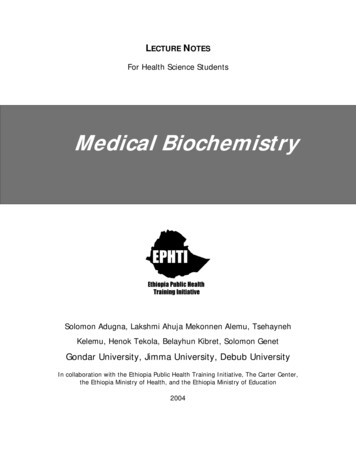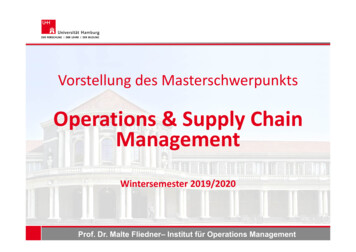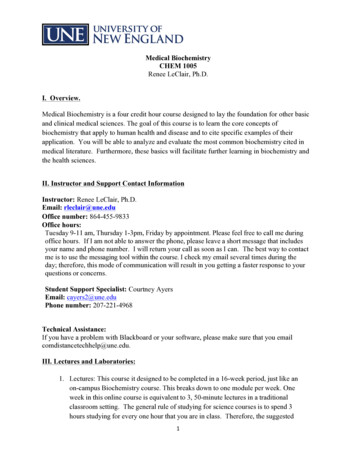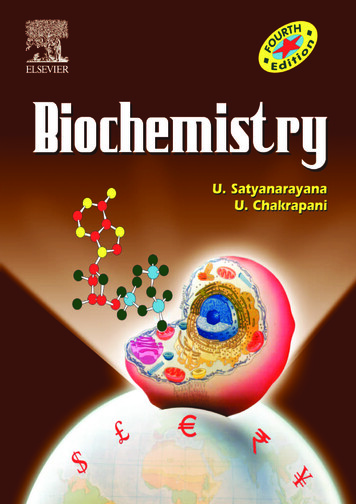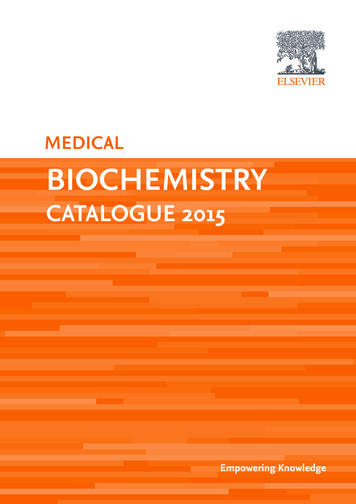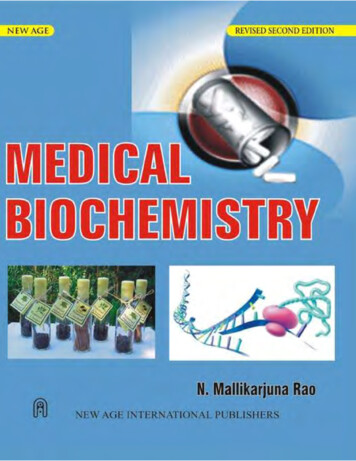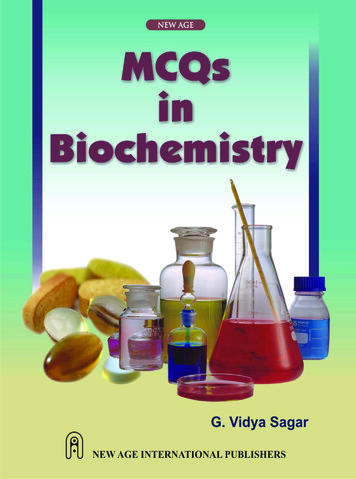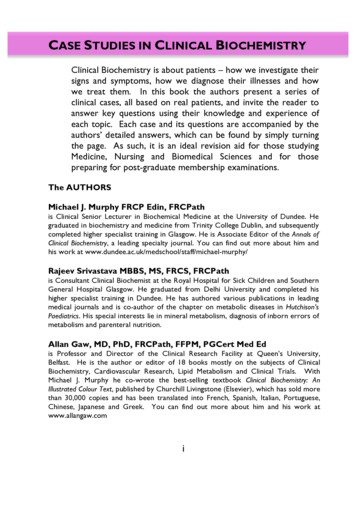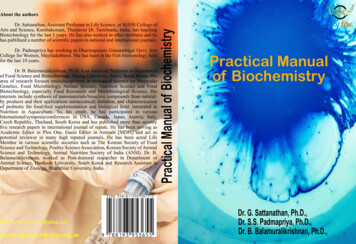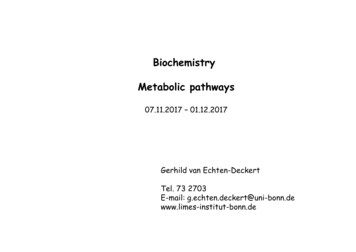
Transcription
BiochemistryMetabolic pathways07.11.2017 – 01.12.2017Gerhild van Echten-DeckertTel. 73 2703E-mail: n.de
Objectives of the course:Energy metabolismhigh-energy donorscoupled reactionsco-factors: NAD /NADH; FAD/FADH2; TPP; PLP; CoA; Biotinglycolysis/glyconeogenesiscitric acid cycle: regulation (tissue-dependent)GABA-shunt;glyoxylate cyclerespiratory chain and oxidative phosphorylationglycogen metabolism (activated glucose)pentose phosphate pathway (tissue specificity)photosynthesis: RUBISCOC4-plants
Nitrogen metabolismN2 assimilation via reduction to NH3 (nitrogenase complex)NH3 metabolism: glutamate-dehydrogenaseglutamate synthaseglutamine synthetaseglutamine amidotransferaseurea cycleC1 metabolism (PLP, THF, SAM, homocystein)nucleotide metabolism: biosynthesis of purines and pyrimidinesfrom RNA to DNA (NDP reductase)salvage pathway, HGPRT deficiencycytostatic drugscatabolism (ADA-deficiency, urate)Signal transductionGPCR – glucagon signallingRTK – insulin signallingG-proteins
Structural hierarchy in the molecular organization of cellsLehninger Principles of Biochemistry. 5th Ed.Nelson & Cox
Essential Questions? What are the properties of regulatory enzymes?How do regulatory enzymes sense the momentary needs of cells?What molecular mechanisms are used to regulate enzyme activity?Factors that influence enzymatic activityGeneral features of allosteric regulationThe kind of covalent modification that regulates the activity of enzymesIs the activity of some enzymes controlled by both allosteric regulation andcovalent modification?Special focus: is there an example in nature that exemplifies the relationshipbetween quaternary structure and the emergence of allosteric properties?hemoglobin and myoglobin – paradigms of protein structure and function
What Factors Influence Enzymatic Activity? The availability of substrates and cofactors usually determines how fastthe reaction goes. Km values the prevailing in vivo concentration of the substrates As product accumulates, the apparent rate of the enzymatic reaction willdecrease as equilibrium is approached Genetic regulation of enzyme synthesis and decay determines theamount of enzyme present at any moment Induction activation of enzyme synthesis Repression shutdown of enzyme synthesis By controlling the [E], cells can activate or terminate metabolicroutes. Other factors: Zymogens, isozymes, and modulator proteins may play arole
Principal characteristics of metabolic pathways1.Metabolic pathways are irreversible.2.Catabolic and anabolic pathways must differ.3.Every metabolic pathway has a first committed step.4.All metabolic pathways are regulated.5.M.p. in eukaryotic cells occur in specific subcellular compartments.
Metabolic Regulation Requires Different Pathways forOppositely Directed Metabolic SequencesParallel pathways of catabolism and anabolism must differ in at least one metabolic step inorder that they can be regulated independently. Shown here are two possible arrangementsof opposing catabolic and anabolic sequences between A and P. (a) Parallel sequences proceedby independent routes. (b) Only one reaction has two different enzymes.
Metabolic Pathways are Compartmentalized within Cells Eukaryotic cells are compartmentalized by an endomembrane system –advantageous for metabolismEach organelle (compartment) – dedicated to specialized metabolicfunctions and contains appropriate enzymes – confined together. Advantages:– Allow analyses of respective functions because they can be separated– Enzymes are isolated from competing pathways– Temporal compartmentalization– Intermediates are spatially and chemically segregated– Genes of metabolism show a circadian pattern of regulated expression– Example: glucose-6 phosphatase that converts glucose-6-phosphate toglucose is localized in the ER.
Where metabolic processes occur at the organ levelLiver Liver is the center of metabolism – maintains blood glucose levels andregulates the concentration of metabolites in the blood. Stores glycogen that can be made into glucose-6-phosphate, then glucose. Makes glucose by gluconeogenesis (from pyruvate, de novo). Synthesizes FA, cholesterol and bile salts. Produces ketone bodies but cannot use them (no CoA transferase in theliver) Only the liver and kidneys contain glucose-6-phosphataseGlucose regulation in the liver When blood glucose is high (fed state), FA are synthesized by the liver,converted into triacylglycerols and packaged into VLDL that are secretedinto the blood. When blood glucose is low (fasting state), the liver produces ketone bodiesto fuel the heart and muscle to preserve glucose for the brain. Eventuallybrain is fed by ketone bodies.
Other organs in metabolism Brain - Glucose is the primary fuel; only after prolonged fasting (noteating) does the brain use ketone bodies for fuel (last resort).– Brain has no capacity to store fuel – needs a constant supply– Consumes a lot of energy – 120 g of glucose per day.– Glucose is transported into the brain by GLU3 glucose transporter(crosses the membrane).– [glucose] in brain – maintained around 5 mM so glucose is saturatedunder normal conditions. If drops to 2.2 mM the brain is in trouble.Muscle - uses glucose, FA and ketone bodies for fuel; have stores ofglycogen that is converted to glucose when needed for bursts of activity.IntestinesKidneyAdipose tissueHeart
Metabolic principle: Degradation is coupled to the formation of ATP (energy store)and NADPH (reduction equivalents), that represent sources of free energy forbiosynthetic reactions.Biochemistry. Voet & Voet
high-enthalpy, low-entropyOverview of catabolismlow-enthalpy, high-entropyBiochemistry. Voet & Voet
Stage 1: Proteins,polysaccharides and lipids arebroken down into theircomponent building blocks.Stage 2: The building blocksare degraded into the commonproduct, generally the acetylgroups of acetyl-CoA.Stage 3: Catabolism convergesto three principal end products:water, carbon dioxide, andammonia.Biochemistry. Voet & Voet
The central role of ATP for energy exchange in biologicalsystems was discovered in 1941 by Fritz Lipmann undHerman Kalckar.ATP-turnover: 40 kg/dayEnergy rich compounds: the triphosphate subunit, contains2 phosphoric acid anhydride linkages, which upon hydrolysisrelease high amounts of energy:ATP H2OATP H2OADP Pi H AMP PPi H G ‘ -30,5 kJ/mol G ‘ -30,5 kJ/molATP, ADP, AMP, interconversionable: adenylate-kinase:ATP AMPADP ADPATP is continuously formed and hydrolysed.
Biochemistry. Voet & Voet
Transfer of the phosphate group from “high-energy” donors via ATP to“low-energy” acceptors:Biochemistry. Voet & Voet
Lehninger Principles of Biochemistry. 5th Ed.
When a sudden demand of energy depletes ATP, the PCr reservoir is used to replenish ATP at a rateconsiderably faster than possible via catabolism.Vice versa, when demand of energy is reduced, ATP produced by catabolism is used to replenishthe PCr reservoir.Lehninger Principles of Biochemistry. 5th Ed.Nelson & Cox
Structure of Acetyl-CoA:a „high-energy“ thioester of thenucleotide cofactor Coenzyme A G0’ –31 kJ/mol
Lehninger Principles of Biochemistry. 5th Ed.Nelson & Cox
Lehninger Principles of Biochemistry. 5th Ed.Nelson & Cox
The central role of Acetyl-CoA inmetabolism:Citric acid cycleMetabolic intermediate:Fatty acid metabolismCarbohydrate metabolismAmino acid metabolismPrecursor of cholesterol and steroid hormonesAcetyl-group donor:Choline: Acetylcholine (neurotransmitter)Lys of histonesBiochemistry. Voet & Voet
Three types of nonlinear metabolic pathwaysLehninger Principles of Biochemistry. 5th Ed.Nelson & Cox
NAD and NADP accept e- only pairwise („parking“ an hydride ion)Lehninger Principles of Biochemistry. 5th Ed.Nelson & Cox
Lehninger Principles of Biochemistry. 5th Ed.Nelson & Cox
NAD and NADP , NADH and NADPH are cofactors in more than 200reactions (type electron transfer):AH2 NAD(P) A NAD(P)H H Enzymes: eCH3CH2OH NAD CH3CHO NADH H
[NAD ] [NADH]Total concentration [10-5 M]Enables catabolic oxidations[NADP ] [NADPH]Total concentration [10-6 M]Enables anabolic reductionsNiacin deficiency causes Pellagra (3 Ds: DermatitisDiarrhoeaDementia).
FMN and FAD are able tosequentially transfer one e-Biochemistry. Voet & Voet
Lehninger Principles of Biochemistry. 5th Ed.Nelson & Cox
Non-enzymatic glucosylation of proteinsReversible generationof a Schiff baseIrreversibleAmadori-rearrangement
Nitrogen metabolism N 2 assimilation via reduction to NH 3 (nitrogenase complex) NH 3 metabolism: glutamate-dehydrogenase glutamate synthase glutamine synthetase glutamine amidotransferase urea cycle C 1 metabolism (PLP, THF, SAM, homocystein) nucleotide metabolism: biosynthesis of
